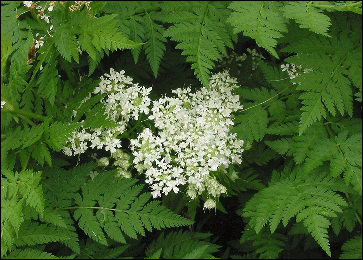What are the Uses and Health Benefits of Chervil (Anthriscus Cerefolium)?
Introduction
World Health Organization (WHO) has estimated that 80% of the people worldwide rely on herbs for the treatment of various disorders. Herbs are considered as the natural medicine that are widely used in traditional system of medicine. Herbs are becoming increasingly popular throughout the world. According to WHO, around 21,000 plant species have the potential for being used as medicinal plants.

One such plant is Chervil which has the potential to be used in the novel medicines throughout the world. Chervil belongs to the carrot family and its leaves highly resemble carrot tops. In ancient times, this plant was believed to symbolize revitalization. This plant doesn't pose any danger to health and can be consumed in large quantities. It is quite nutritious. The entire herb is edible but the roots and leaves are more commonly used. It is a good source of minerals and vitamins and possesses broad pharmacological activities.
Chervil is classified into four main varieties. These varieties are: Garden Chervil, Wild Chervil, Root Chervil and Bur Chervil. Out of all these varieties, garden chervil is most commonly used.
Chervil commonly known as Gourmet's Parsley is a very delicate herb but full of nutritional value. This plant has 12 species, some of which are noxious in nature.
Geographical Distribution
Chervil is native to the Caucasus but was spread to most of the Europe by the Romans, temperate parts of Asia. It is also most popular in England, Germany and America. It is not cultivated in India.
- Botanical Name: Anthriscus Cerefolium
- Common Name: Chervil, French Herb, Rich Man’s Parsley
- Family: Apiaceae (Umbelliferae)
- Edible Part: Leaves and Root
Morphological Characteristics
It is an annual plant which grows up to a height of 12-24 inches and its leaves are lacy, fern like, light green in colour and they are sub-divided again into opposite and deeply cut leaflets. The flowers are white in colour, dainty, delicate and arranged in tiny umbels. The fruits are oblong, segmented and beaked.
Pharmacological Importance
- Expectorant: Facilitates the secretion of mucus from the respiratory tract.
- Digestive: Due to the presence of fiber, it promotes digestion.
- Anti-oxidant: It acts as an anti-oxidant because it combats free radicals which helps in increasing immunity.
- Anti-inflammatory: Its anti-inflammatory properties make it an effective herb for cold and flu.
The leaves of this herb have digestive action therefore the infusion of fresh leaves is used for digestive disorders.
Health Benefits
Skin Disorders:-
Due to the anti-inflammatory properties of this herb, it is used in suppurative and inflammatory skin disorders such as acne (an inflammatory disease of the sebaceous gland) and eczema. (Characterized by redness, itching, inflammation).
Due to its effectiveness in skin disorders, this herb is used as an ingredient in creams for hemorrhoids and varicose veins.
Blood Disorders:-
Due to its blood thinning and anti-hypertensive properties, this herb is used for normalizing high blood pressure.
- It is also a rich source of iron and zinc, therefore it fights against anemia.
- Chervil is also known for increasing blood circulation and useful in the treatment of varicose veins.
- It is also useful in the treatment of low blood pressure as well.
Cardiovascular Health:-
Impaired unavailability of nitric oxide (NO) in the vascular system can lead to cardiovascular disorders which can be prevented by the consumption of adequate nitrate and nitrite molecules.
The best sources of nitrate and nitrite in the diet is the consumption of green leafy vegetables and chervil is one of the richest sources of nitric oxide.
Cough and Bronchitis:-
Chervil is an herb known for its expectorant property as it removes excess mucous from the respiratory tract.
Diuretic in Nature:-
Chervil herb is diuretic in nature, therefore, it helps in the process of excretion by promoting urination which leads to the removal of toxins and waste materials from the body.
It is also useful in the treatment of cystitis, kidney and bladder stones.
Acts as a Detoxifying Agent:-
Being a detoxifying agent, it reduces the appearance of early signs of aging like fine lines, dark spots, wrinkles etc.
This herb also purifies blood which makes the skin look smoother and younger.
Other Uses
- Chervil herb prevents and cures ulcers in the mouth and also useful in gum diseases.
- For stopping hiccups, chew some fresh chervil leaves.
- This herb is useful for the patients of depression as well as it provides a bit of bolster to human brain functioning as well.
- It is also used in the preparation of herbal eye wash as it relieves soreness and swelling. It is also a rich source of Vitamin A therefore useful in increasing eye vision.
- This herb acts as a tonic for the body as it tones the epithelial lining, thereby soothes the internal organs.
- An infusion of fresh leaves is used as a skin lotion and cleanser and the juice of its stem and leaves are rubbed on blemishes.
- The extract of chervil herb is very effective in the treatment of menstrual cramps.
Flavoring Agent
Both leaves and stem parts of this plant are used for cooking.
- This herb is also used as a flavoring agent. Its flavor is lost very easily either by drying the herb or due to too much heat. So, it should be used in raw form.
- Its leaves act as an attractive herb therefore used for garnishing purposes.



